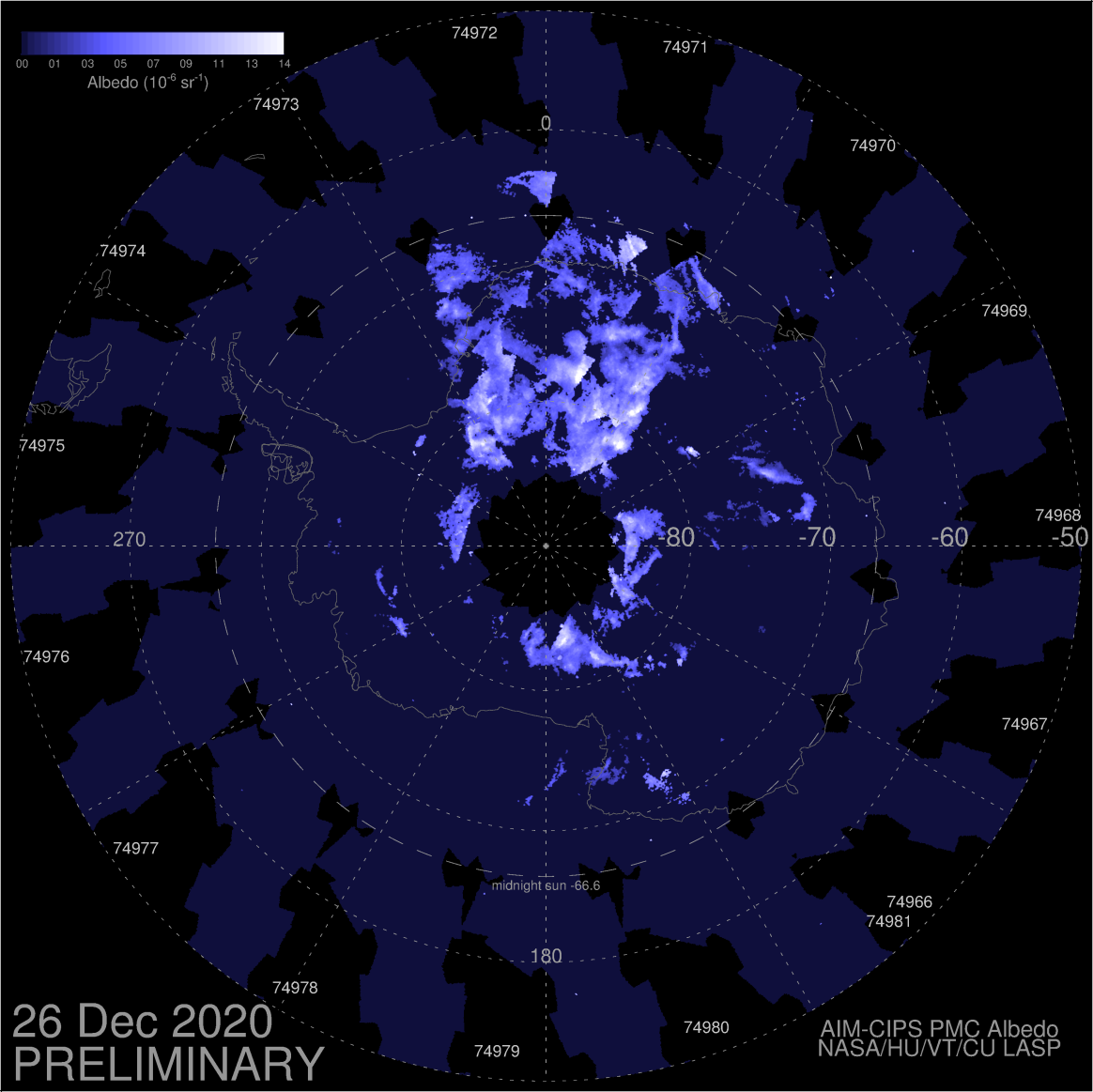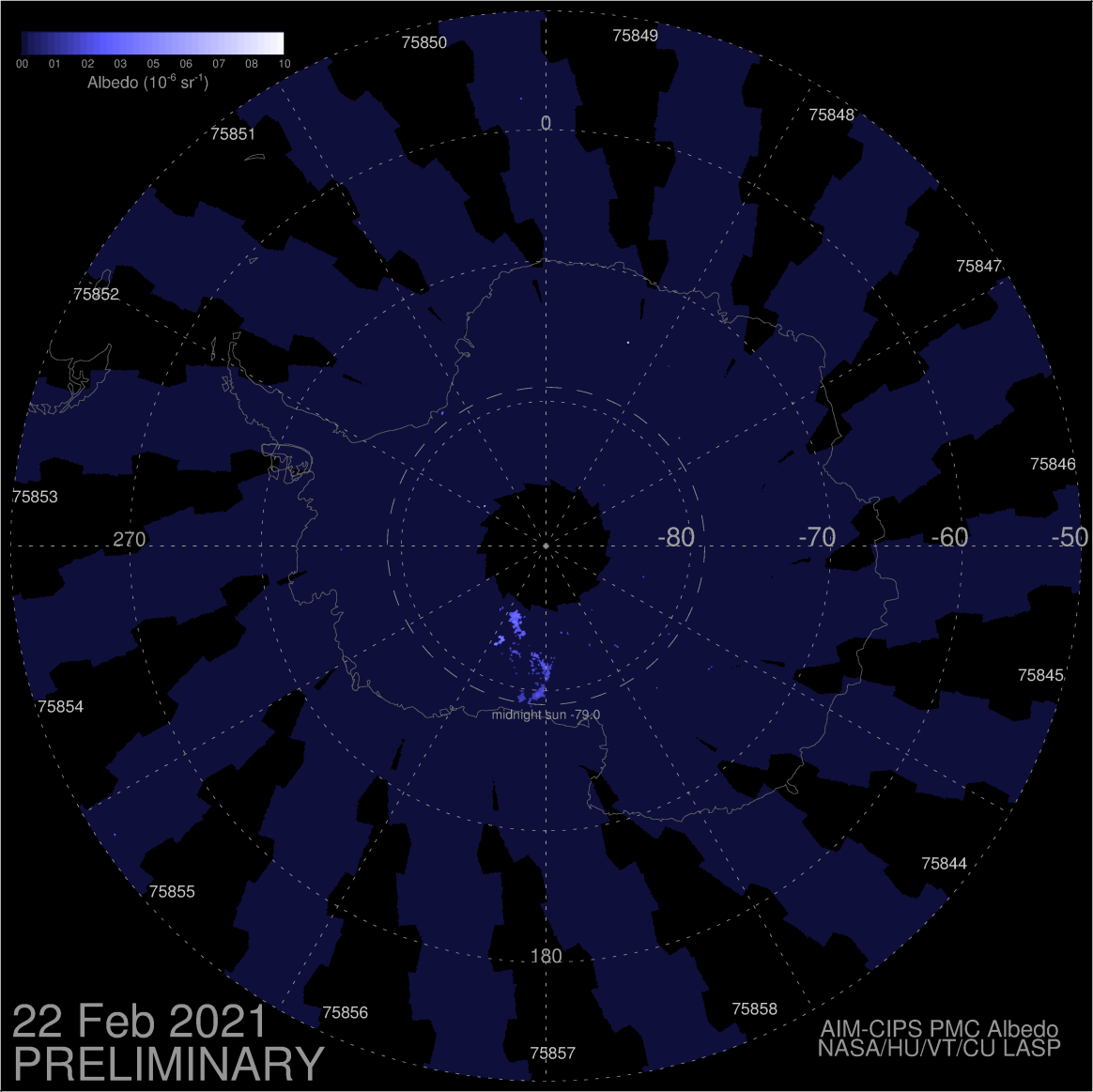Noctilucent Cloud in the Antarctic 2020 – missing
Forums › The Cloud Forum › Noctilucent Cloud in the Antarctic 2020 – missing
Tagged: 2020, Antarctic, mesosphere, NLC, troposphere
- This topic has 6 replies, 3 voices, and was last updated 3 years, 1 month ago by
 John Murrell.
John Murrell.
-
AuthorPosts
-
-
December 28, 2020 at 10:12 am #462172
 John MurrellParticipant
John MurrellParticipantThe Antarctic NLC season usually begins in Late November or Early December. There are not many observations due to the lack of habitation in the latitudes where it is visible. However the NASA AIM satellite is able to spot NLC but this year there has been almost none. By now most of the continent should be covered in NLC though a lot will not be visible from the ground as it does not get dark enough.
The reason there is no NLC is believed to be connected to some very unusual atmospheric conditions over the continent including a very large Ozone Hole – who said it is disappearing !
A more detailed summery of the unusual weather is at https://spaceweatherarchive.com/2020/12/02/strange-antarctic-weather-extends-to-the-edge-of-space/
The AIM spacecraft page is at http://aim.hamptonu.edu/ with a link in the top right to see the daily images – these are also published on SpaceWeather.com.
Apologies about a post about missing clouds !
-
December 28, 2020 at 11:19 pm #462308
 Hans StockerParticipant
Hans StockerParticipantThanks for sharing this information John. Very interesting a nd intriguing.
-
December 29, 2020 at 8:52 am #462362
 John MurrellParticipant
John MurrellParticipantAn update spaceweather.com has the missing NLC featured on their daily webpage see https://spaceweather.com/archive.php?view=1&day=29&month=12&year=2020 . The images shown were from the 24th December . There is an update to the latest image from 26th December at

Where activity seems to have increased a lot over a couple of days. So now it is back to cloud appreciation !
It is interesting to note that the formation of NLC requires gravity (buoyancy) waves to carry water high enough for NLC to form in the normally dry troposphere. There is a link to a page on Gravity Waves at https://www.weather.gov/source/zhu/ZHU_Training_Page/Miscellaneous/gravity_wave/gravity_wave.html – note some images are missing. In some of the Northern Hemisphere NLC movies I have seen the gravity waves are visible as stationary features with the NLC pouring over them like a waterfall.
-
This reply was modified 3 years, 3 months ago by
 John Murrell.
John Murrell.
-
This reply was modified 3 years, 3 months ago by
-
December 29, 2020 at 3:37 pm #462411
Laurence Green
ParticipantThank you, John, for this interesting news.
I wonder if the lack of noctilucent cloud(s) might be attributed to climate change?
Here is a marvellous photo of such a cloud over central Paris, France, taken on 28 June 2019 – the image comes from the NASA APOD (Astronomy Picture Of the Day) website – here it is:-
https://apod.nasa.gov/apod/ap190628.html
I know that among the CAS membership a member by the name of Lucy, nickname, “Noctilucy” will, I think, be interested in this and other similar postings as she seems very interested in this type of cloud formation.
Laurence
-
December 29, 2020 at 4:20 pm #462414
 John MurrellParticipant
John MurrellParticipantI have been imaging the Northern NLC for several years – from what I have seen in recent years they seem to have moved from being post Sunset to being a morning pre-sunrise phenomena.
In terms of the climate change link it is normally considered that that climate change is increasing the numbers of NLC rather than reducing them. For some weird reason of atmospheric physics / chemistry the Mesosphere gets colder in the summer while the lower parts of the atmosphere gets warmer. NLC require three things to form – very cold temperatures, water vapour that should not be in the mesosphere and dust nuclei to condense on which also should not be in the mesosphere. One theory is that the dust particles come from space – from burning meteors. The big mystery is why they were first recorded in 1885 two years after the explosion of Krakatoa. This probably pushed dust into the Mesosphere but there have been previous large volcanic eruptions that would have done the same. Meteors as a source of dust particles have been burning up for ever so that is not a reason.
The remaining reasons are: they were there but no one noticed / recorded them. This seems unlikely with places like the Royal Observatory having observers looking north from Greenwich every clear night. Also a remarkable number of other atmospheric phenomena were recorded. The other possible reason is that the mesosphere got colder or wetter in the 1880’s but why ?
-
December 31, 2020 at 11:53 am #462729
 John MurrellParticipant
John MurrellParticipantFor those who may not have looked at the AIM ‘Daily Daisy’ images before they are a bit different to normal satellite images. The image is a composite of observations during several satellite passes these produce the ‘petal’ pattern seen in the dark blue in the images. The black area have no observations including the area over the South pole. The faint grey is the outline of the continent as well as the tip of South America at about 280 degrees.
The dashed circle shows the limit of the midnight sun so it is daylight South of this and the NLC while visible from space by the AIM satellite will not be visible from the ground. The lack of populated landmass north of this line is probably the reason there are so few observations of NLC from the southern hemisphere. NLC is worth a lot of points in my cloud collecting book – southern NLC should be worth at least 10 times as much.
-
March 2, 2021 at 10:29 am #474353
 John MurrellParticipant
John MurrellParticipantIt appears that the southern Summer Noctilucent Cloud season has ended. The last trace of NLC appears on the AIM image from the 22nd February 2021 see below:

Lets hope for a good NLC season in the North this year, it should begin in late May or June. Keep an eye on speceweather.com for updated images from AIM.
-
-
AuthorPosts
- You must be logged in to reply to this topic.




